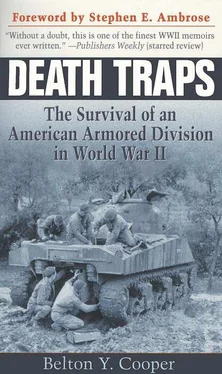Her father had been convinced by Hitler and the continuous stream of German propaganda that Americans were barbarians. He was told that if the Americans ever occupied Darmstadt, he and his entire family would be brutally tortured and put to death. He, his wife, and daughter made a pact that if such came to pass, they would all take cyanide capsules before the Americans arrived.
In late February 1945, when the American Third Army crossed the Rhine at Oppenheim, her father called the family together in the living room. He told the daughter to leave the two little girls, approximately three and five years old, in one of the bedrooms behind a closed door. He then distributed five cyanide capsules. The mother and father took their capsules and died quickly. She took the capsules for the children and put them in candy that she had prepared. She gave the candy to the children and stayed with them until they became unconscious. When she was convinced they were dead, she took her capsule and collapsed.
Shortly afterward, American troops reached Darmstadt and found the five bodies in the house. She apparently had regurgitated the capsule in her unconscious state and was still breathing when the troops arrived. The medics revived her, then took her to the Catholic hospital and turned her over to the nuns. When she finally revived sufficiently to realize what had happened, she was in a state of shock. How could she possibly have believed the Americans were barbarians when they instead had saved her life. She had become such a pawn of Nazi propaganda that she had killed her own children. This was more than she could cope with, and she cut her wrists with a razor. The German nurses found her in a pool of blood and managed to save her again.
It’s relatively easy to accept the fact that propaganda can be a powerful weapon among backward, uneducated people.
This young woman, on the other hand, had had all the privileges of an aristocratic upbringing in a modern nation and had even gone to school in France and England. How could she possibly believe Americans were barbarians who would torture and kill her little girls?
One would think that after ten months of combat, nothing would shock you. As I was fortunate not to have been a tanker or infantryman exposed to terror on a twenty-four hour basis, I was perhaps more sensitive to shock. In any event the death camps in Nordhausen, Belsen, and Auschwitz and incidents such as this were bound to shock even the most insensitive person. How could any civilized people, on the face of this earth, possibly have been brought to do what the Germans did in this war? Man’s inhumanity to man seemed limitless. To this day, I’ve never heard a reasonable explanation of how this could have happened in a modern civilized world. I have no answers to this terrible question.
After two weeks at Darmstadt, we had caught up on our maintenance and had time to relax. The photographic equipment we had found in the Agfa plant came in handy. We set up our own lab and started developing pictures, not just our own but also film that we had found in many captured German cameras.
One roll of film, apparently taken by a German guard in one of the death camps, showed the slave workers in the process of burning the bodies. The corpses were stacked in piles along the wall at the end of the crematorium vault. There appeared to be fifteen to twenty furnaces in the crematorium. The workers used large clamps to grab the head and feet of the naked corpses and drag them across the floor to a small conveyor in front of each furnace. They loaded the corpses on the conveyor head first and used a long poker in the crotch to push the bodies into the furnace.
As soon as the first conveyor was loaded, the workers would load the next one. By the time they had loaded all the furnaces, they would come back to the first one and start all over again. Any bits of bone or residue remaining on the conveyor were brushed into the ash pit. The workers’ faces appeared void of any emotion.
Several years after the war, a set of these pictures appeared in the holocaust museum in Atlanta, Georgia.
Major Arrington had us bring our final combat loss reports up-to-date. He told each liaison officer to review his records and those of the maintenance battalion shop work order clerk to make sure we had not missed anything. We went through all the records and tried to recount as accurately as possible every incident of vehicles being knocked out or damaged and repaired. After many hours, the final record was compiled and turned over to the division, which in turn sent it to the War Department for historical documentation. A summary copy of these records appeared in the 3d Armored Division history, entitled Spearhead in the West.
During this period, I received a ten-page V-mail letter from my Aunt Betty in Nashville, Tennessee. She was my grandmother’s youngest sister, and I had fond memories of the summers that she and the young grandchildren spent together in my grandfather’s house on the mountain in Huntsville. She would show us postcards of her trip to Europe many years before and would tell us stories about castles on the Rhine and knights and their exploits in great battles in the glorious past. Little did I realize as a little boy that I would someday be involved in similar exploits in this same land.
In her long letter, Aunt Betty described a trip she had taken with her father to Germany in the early 1890s, when she was seventeen years old. They had been invited to visit the family of a German music teacher in Rüdesheim, a small village on the east bank of the Rhine across the river from Mainz. The day they arrived in Rüdesheim on the train from Berlin, the Germans were celebrating the dedication of the Germania Denkmal (monument), a huge bronze statue cast from French cannon captured by the Germans during the Franco-Prussian war in 1871. The statue represented Germania, the German goddess of war, and was the largest statue in the world at the time.
The American ambassador and his daughter, who had been invited to participate in the dedication, were supposed to arrive on the same train from Berlin but had missed the train. My great-grandfather and aunt were mistakenly identified as the ambassador and his daughter and were given seats as guests of honor. While the bürgermeister and other high German officials gave numerous speeches, my aunt was given a beautiful bouquet of flowers and a red, white, and blue cockade to wear on her hat. Not until the ceremony was over did she finally comprehend what had taken place.
After reflecting on this event for some fifty years and through two world wars, she felt that this statue represented the height of German-Prussian militarism and wanted me to blow it up. This was the purpose of her letter. I was shocked to read that the woman I had regarded as a sweet little old lady music teacher had harbored such aggressive thoughts all these years. I looked at my map and discovered that Rüdesheim was only about seventy-five miles from Darmstadt. I decided to go there.
My aunt had described in the most minute detail the layout of the village and gave me the address of the house where she had stayed, number ten Schmidthoff. I soon found the street and the little courtyard with a small chapel and a fountain, which my aunt had described; she remembered having seen it from her bedroom window. I went around to the front of the house and found the number ten almost covered by an overhanging thatched eave. I took several pictures of the house, clearly showing the address.
We found the road that wound up the hill through the Niederwald to the Germania statue, still standing in all its majesty. Including its large stone pedestal, the statue was well over a hundred feet tall. From the shell craters around it and from the blasts on the stone base, we could tell that the area had been subjected to heavy shelling. The statue itself did not appear to have taken any direct hits, but there was great evidence of strikes by shell fragments. Perhaps the Germans had used this as an observation post, and the shelling was an attempt to neutralize it. On the front of the stone base was inscribed in large letters Wacht am Rhein (“watch on the Rhine”).
Читать дальше












